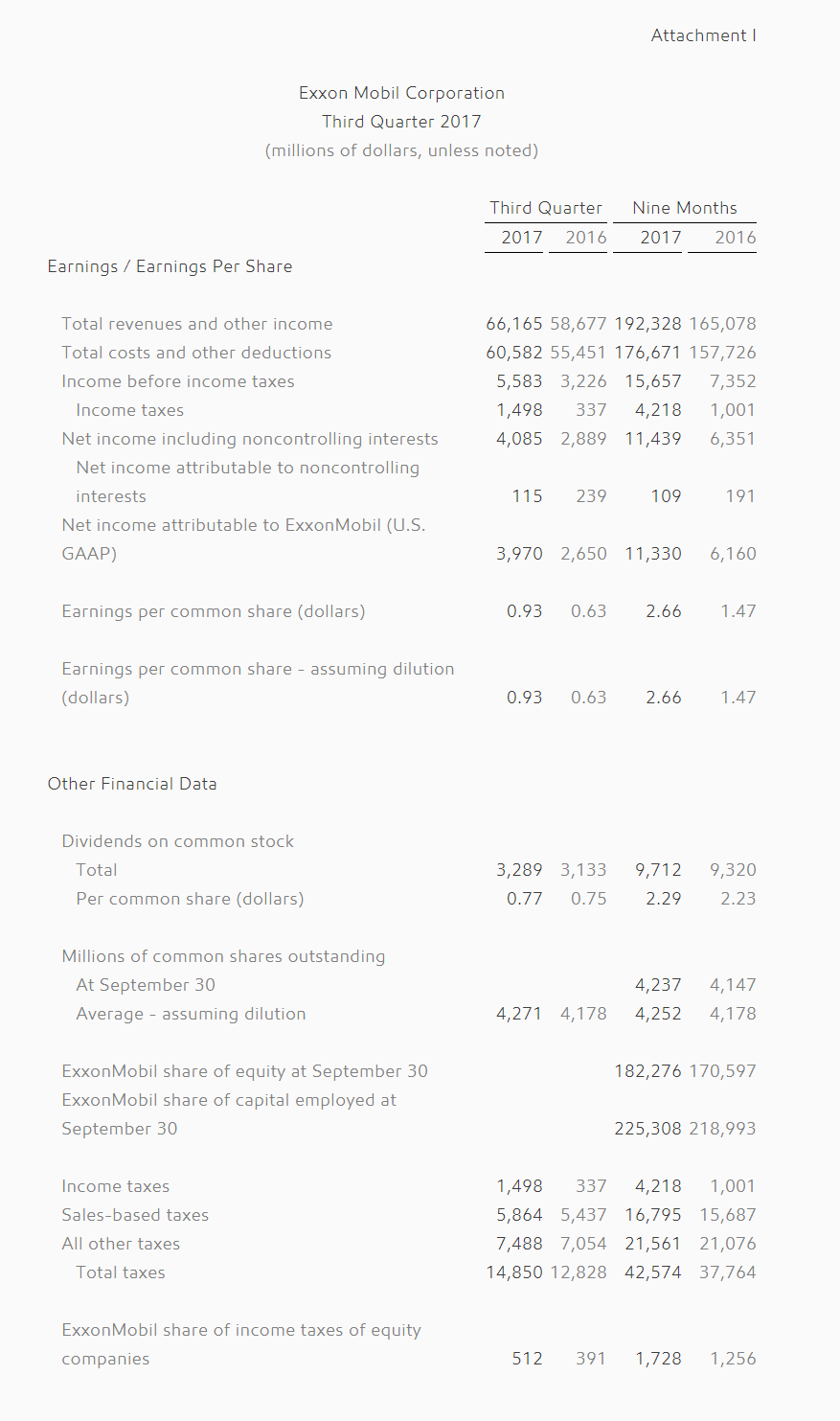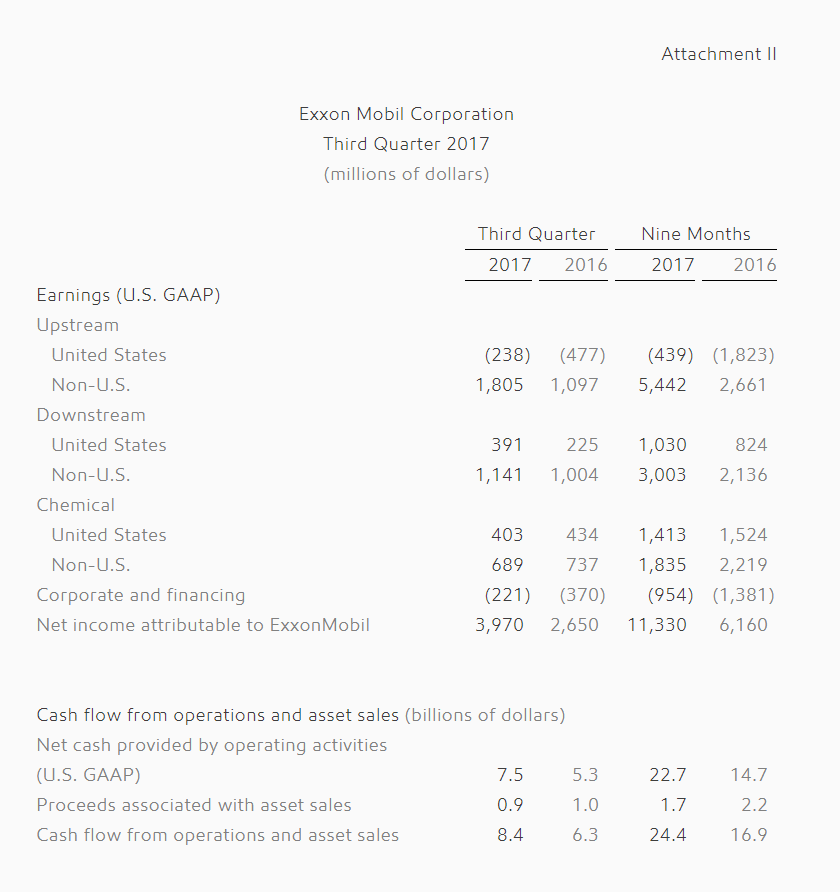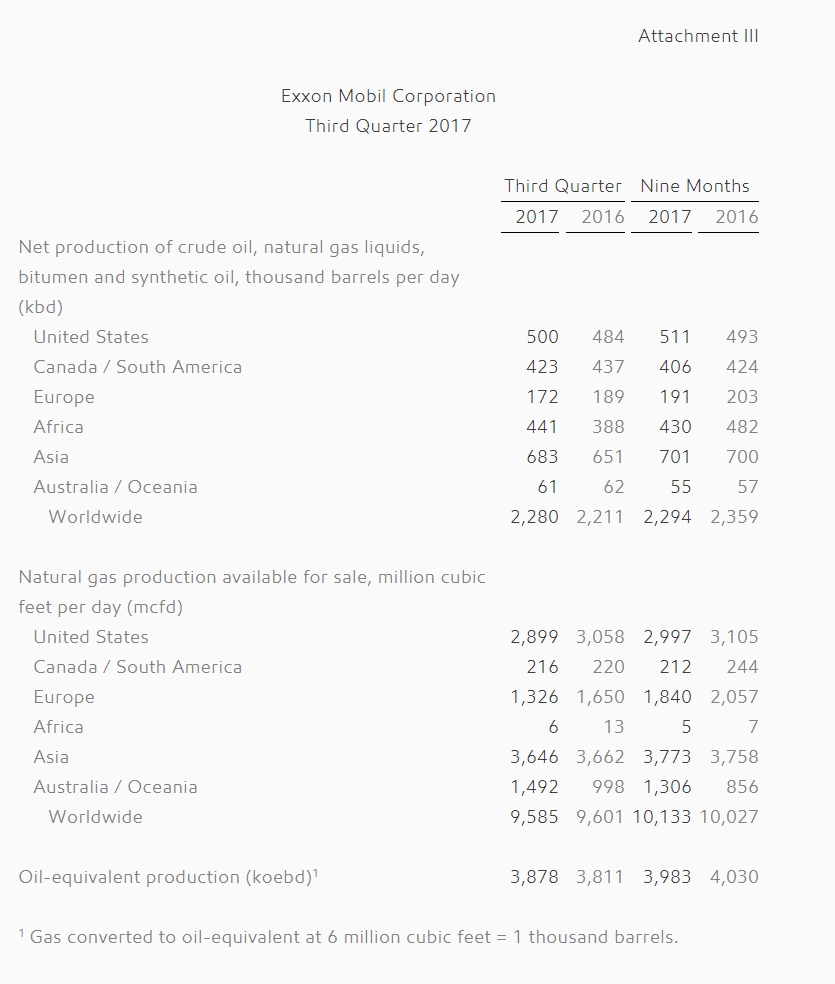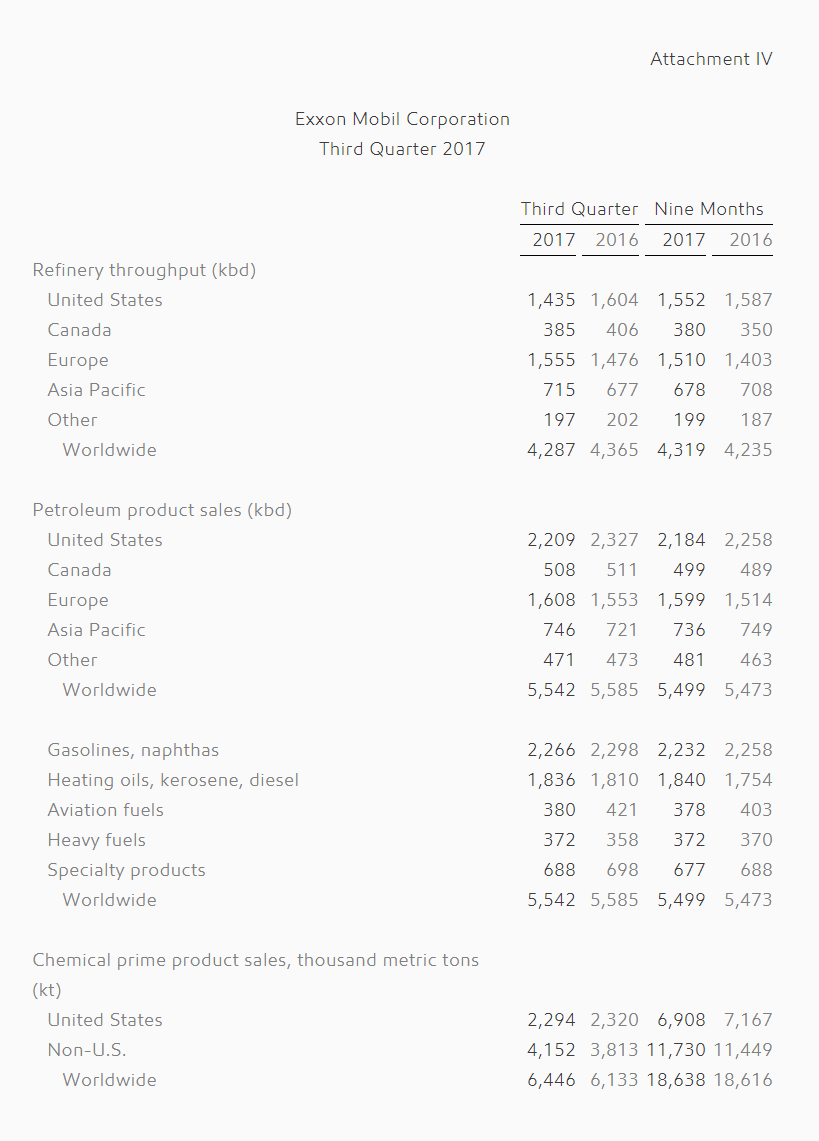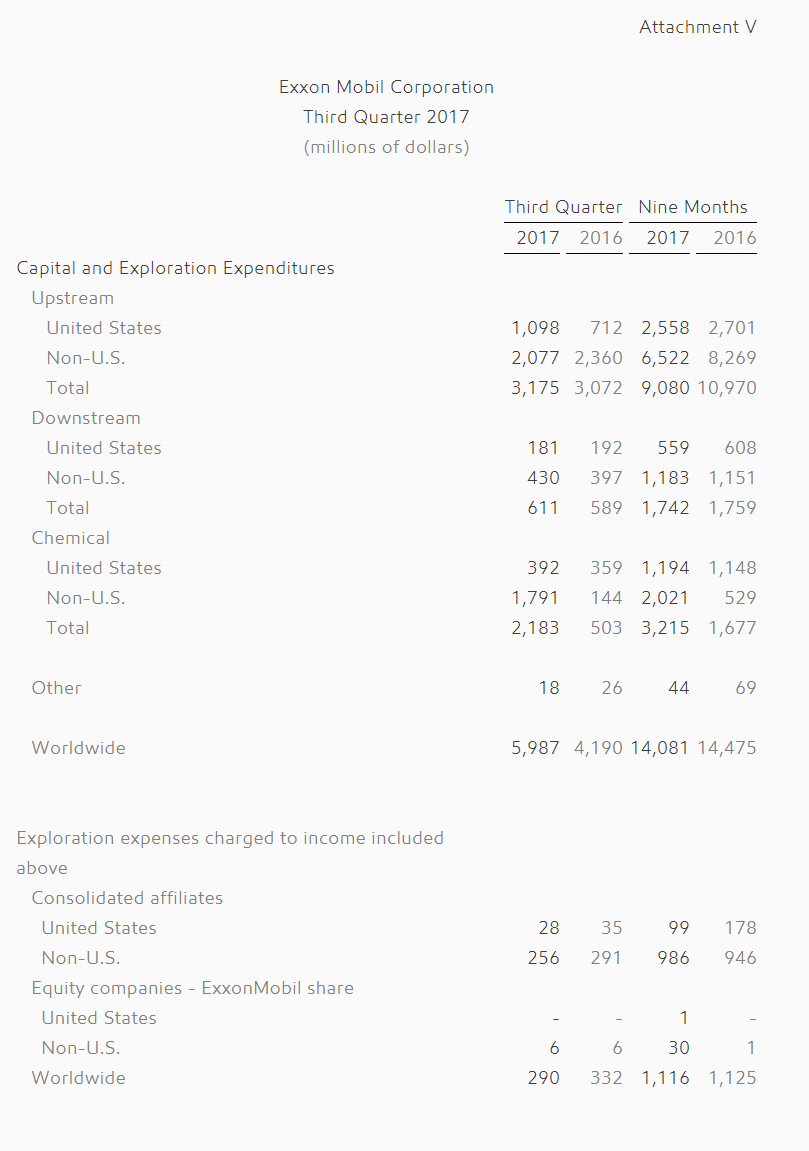ExxonMobil Earnings Rise 50 Percent To $4 Billion On Solid Business Performance
IRVING, Texas--(BUSINESS WIRE)--Exxon Mobil Corporation (NYSE: XOM):
- Cash flow from operations and asset sales exceeds dividends and net investments1 for the fourth-consecutive quarter
- Company makes fifth Guyana discovery; captures 12 high-potential blocks offshore Brazil
- Hurricane Harvey reduces earnings by an estimated $160 million, or 4 cents per share
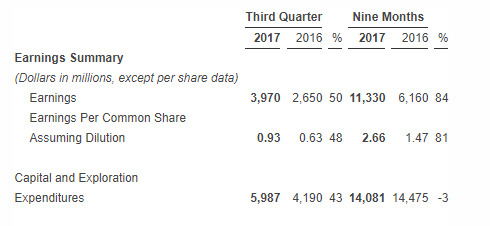
Exxon Mobil Corporation announced estimated third quarter 2017 earnings of $4 billion, or $0.93 per diluted share, compared with $2.7 billion a year earlier as commodity prices improved and performance in the Upstream and Downstream strengthened. Impacts related to Hurricane Harvey reduced earnings by an estimated 4 cents per share.
“A 50 percent increase in earnings through solid business performance and higher commodity prices is a step forward in our plan to grow profitability,” said Darren Woods, chairman, and chief executive officer. “For the fourth-consecutive quarter, we generated cash flow from operations and asset sales that more than covered our dividends and net investments in the business.”
Upstream earnings rose to $1.6 billion as commodity prices increased. Building on its recent success in deepwater exploration, such as the Turbot discovery in Guyana, ExxonMobil added 12 offshore blocks in Brazil, capturing acreage with high resource potential and competitive fiscal terms.
Downstream results increased to $1.5 billion, despite Hurricane Harvey impacts and the absence of favorable asset management gains of $380 million in the prior year from the sale of Canadian retail assets. These results were achieved as the company worked quickly to safely bring refineries back online following the storm and to restore product supplies.
Chemical earnings were $1.1 billion, down slightly from a year ago on lower commodity margins and hurricane impacts, partially offset by volume growth. During the quarter the company enhanced its position to capture growing demand in Asia by completing the purchase of an aromatics plant in Singapore.
1Includes additions to property, plant and equipment and net investments/advances
Third Quarter 2017 Highlights
- Earnings of $4 billion increased 50 percent from the third quarter of 2016.
- Earnings per share assuming dilution were $0.93.
- Cash flow from operations and asset sales increased 33 percent to $8.4 billion, including proceeds associated with asset sales of $854 million.
- Capital and exploration expenditures were $6 billion, including an aromatics plant acquisition in Singapore.
- Oil-equivalent production was 3.9 million barrels per day, up 2 percent from the prior year. Excluding entitlement effects and divestments, oil-equivalent production remained at 2 percent higher than the prior year.
- The corporation distributed $3.3 billion in dividends to shareholders.
- Dividends per share of $0.77 increased 2.7 percent compared to the third quarter of 2016.
- The company acquired an interest in 12 blocks offshore Brazil during the last bid round completed during the quarter. The bid resulted in the addition of 2 million high-potential acres with competitive fiscal terms.
- The company completed the Turbot-1 exploration well offshore Guyana. The well encountered 75 feet (23 meters) of high-quality, oil-bearing sandstone, and represents ExxonMobil’s fifth discovery to date in the country.
- ExxonMobil signed a production sharing contract for Block 59 located 190 miles (305 kilometers) offshore Suriname. The deepwater block has an area of 2.8 million acres and significantly expands the corporation’s operated acreage in the Guyana-Suriname basin.
- During the quarter, ExxonMobil announced it added 22,000 acres since May to its Permian Basin portfolio through a series of acquisitions and acreage trades. Located in the Delaware and Midland Basins, the new acreage adds over 400 million oil-equivalent barrels to the company’s existing Permian Basin resource base of 6 billion oil-equivalent barrels.
- ExxonMobil completed the acquisition of one of the world’s largest aromatics facilities, located in Singapore, from Jurong Aromatics Corporation Pte Ltd. The acquisition will provide operational and logistical synergies between the plant and ExxonMobil’s integrated refining and petrochemical complex, as well as increase ExxonMobil Singapore’s aromatics production to over 3.5 million metric tons per year.
Third Quarter 2017 vs. Third Quarter 2016
Upstream earnings were $1.6 billion in the third quarter of 2017, up $947 million from the third quarter of 2016. Higher liquids and gas realizations increased earnings by $860 million. Higher volume and mix effects increased earnings by $20 million. All other items increased earnings by $70 million as lower expenses were partly offset by unfavorable foreign exchange effects.
On an oil-equivalent basis, production increased 2 percent from the third quarter of 2016. Liquids production totaled 2.3 million barrels per day, up 69,000 barrels per day as lower downtime and higher project volumes were partly offset by field decline. Natural gas production was 9.6 billion cubic feet per day, down 16 million cubic feet per day from 2016 as field decline and lower demand were partly offset by project ramp-up, primarily in Australia, and work programs.
U.S. Upstream results were a loss of $238 million in the third quarter of 2017, compared to a loss of $477 million in the third quarter of 2016. Non-U.S. Upstream earnings were $1.8 billion, up $708 million from the prior year.
Downstream earnings were $1.5 billion, up $303 million from the third quarter of 2016. Higher refining margins increased earnings by $1 billion. Volume and mix effects decreased earnings by $160 million. All other items decreased earnings by $550 million, reflecting the absence of favorable asset management gains of $380 million in the prior year from the sale of Canadian retail assets and higher expenses related to Hurricane Harvey. Petroleum product sales of 5.5 million barrels per day were 43,000 barrels per day lower than last year’s third quarter.
Earnings from the U.S. Downstream were $391 million, up $166 million from the third quarter of 2016. Non-U.S. Downstream earnings of $1.1 billion were $137 million higher than prior year.
Chemical earnings of $1.1 billion were $79 million lower than the third quarter of 2016. Weaker margins decreased earnings by $200 million. Volume and mix effects increased earnings by $120 million. Third quarter prime product sales of 6.4 million metric tons were 313,000 metric tons or 5 percent higher than the prior year, despite Hurricane Harvey impacts.
U.S. Chemical earnings of $403 million were $31 million lower than the third quarter of 2016. Non-U.S. Chemical earnings of $689 million were $48 million lower than prior year.
Corporate and financing expenses were $221 million for the third quarter of 2017, down $149 million from the third quarter of 2016 mainly due to favorable impacts from the resolution of long-standing tax items.
First Nine Months 2017 Highlights
- Earnings of $11.3 billion increased 84 percent from $6.2 billion in 2016.
- Earnings per share assuming dilution were $2.66.
- Cash flow from operations and asset sales was $24.4 billion, including proceeds associated with asset sales of $1.7 billion.
- Capital and exploration expenditures were $14.1 billion, down 3 percent from 2016.
- Oil-equivalent production was 4 million barrels per day, down 1 percent from the prior year. Excluding entitlement effects and divestments, oil-equivalent production was up 1 percent from the prior year.
- The corporation distributed $9.7 billion in dividends to shareholders.
First Nine Months 2017 vs. First Nine Months 2016
Upstream earnings were $5 billion, up $4.2 billion from 2016. Higher realizations increased earnings by $4.1 billion. Unfavorable volume and mix effects decreased earnings by $300 million. All other items increased earnings by $380 million, primarily due to lower expenses partly offset by unfavorable tax items in the current year.
On an oil-equivalent basis, production of 4 million barrels per day was down 1 percent compared to 2016. Liquids production of 2.3 million barrels per day decreased 65,000 barrels per day as field decline and lower entitlements were partly offset by increased project volumes and work programs. Natural gas production of 10.1 billion cubic feet per day increased 106 million cubic feet per day from 2016 as project ramp-up, primarily in Australia, was partly offset by field decline.
U.S. Upstream results were a loss of $439 million in 2017, compared to a loss of $1.8 billion in 2016. Earnings outside the U.S. were $5.4 billion, up $2.8 billion from the prior year.
Downstream earnings of $4 billion increased $1.1 billion from 2016. Stronger refining and marketing margins increased earnings by $1.3 billion, while volume and mix effects increased earnings by $110 million. All other items decreased earnings by $290 million, mainly reflecting the absence of the Canadian retail assets sale. Petroleum product sales of 5.5 million barrels per day were 26,000 barrels per day higher than 2016.
U.S. Downstream earnings were $1 billion, an increase of $206 million from 2016. Non-U.S. Downstream earnings were $3 billion, up $867 million from the prior year.
Chemical earnings of $3.2 billion decreased $495 million from 2016. Weaker margins decreased earnings by $320 million. Volume and mix effects increased earnings by $70 million. All other items decreased earnings by $250 million, primarily due to higher expenses from increased turnaround activity and new business growth. Prime product sales of 18.6 million metric tons were up 22,000 metric tons from the first nine months of 2016.
U.S. Chemical earnings were $1.4 billion, down $111 million from 2016. Non-U.S. Chemical earnings of $1.8 billion were $384 million lower than prior year.
Corporate and financing expenses were $954 million in 2017 compared to $1.4 billion in 2016, with the decrease mainly due to favorable impacts from the resolution of long-standing tax items.
During the first nine months of 2017, Exxon Mobil Corporation purchased 6 million shares of its common stock for the treasury at a gross cost of $496 million. These shares were acquired to offset dilution in conjunction with the company’s benefit plans and programs. The corporation will continue to acquire shares to offset dilution in conjunction with its benefit plans and programs, but does not currently plan on making purchases to reduce shares outstanding. The company also issued a combined 96 million shares of common stock during the first quarter to complete the acquisition of InterOil Corporation and the acquisition of entities that own oil and gas properties located primarily in the Permian Basin.
Forward-looking Statements
As part of its annual planning and budgeting cycle which is completed in the fourth quarter each year, the corporation develops crude and natural gas price outlooks as well as estimates of future costs and other factors necessary to complete its plan. Management’s price outlook and other factors, including factors such as operating costs, resource productivity, and capital efficiency, are re-assessed when facts and circumstances warrant but no less often than annually. To the extent any impairment testing may be required, management uses assumptions that are reasonable in relation to these factors in developing estimates of future cash flows. An asset group would be impaired if its estimated undiscounted cash flows were less than the asset’s carrying value, and impairment would be measured by the amount by which the carrying value exceeds fair value. Development of future undiscounted cash flow estimates requires significant management judgment, particularly in cases where an asset’s life is expected to extend decades into the future, and an important component of the estimate is management’s outlook on prices and other factors as noted above.
The corporation has identified emerging trends such as increasing estimates of available natural gas supplies and ongoing reductions in costs of supply for natural gas. In the fourth quarter of 2017, the corporation will incorporate the impacts of these trends and the resulting lower price outlook in its annual planning and budgeting cycle. Once complete, the corporation expects to perform an impairment assessment for its North American natural gas asset groups utilizing the information developed as part of the planning and budgeting process. It is not practicable at this time to estimate the impact these trends would have on the undiscounted cash flows for individual asset groups or any resulting impairment charges. However, these trends are likely to place the corporation’s North American natural gas asset groups at risk for potential impairment. The corporation will complete its analysis of relevant factors as discussed above and perform any necessary impairment testing in connection with the preparation of the corporation’s year-end financial statements for inclusion in its 2017 Form 10-K.
ExxonMobil will discuss financial and operating results and other matters during a webcast at 8:30 a.m. Central Time on October 27, 2017. To listen to the event or access an archived replay, please visit www.exxonmobil.com.
Cautionary Statement
Statements relating to future plans, projections, events or conditions are forward-looking statements. Future results, including project plans, costs, timing, and capacities; efficiency gains; capital and exploration expenditures; production rates; resource recoveries; the impact of new technologies; potential impairment charges; and share purchase levels, could differ materially due to factors including: changes in oil, gas or petrochemical prices or other market or economic conditions affecting the oil, gas or petrochemical industries, including the scope and duration of economic recessions; the outcome of exploration and development efforts; changes in law or government regulation, including tax and environmental requirements; the impact of fiscal and commercial terms and outcome of commercial negotiations; the results of research programs; changes in technical or operating conditions; actions of competitors; and other factors discussed under the heading "Factors Affecting Future Results" in the “Investors” section of our website and in Item 1A of ExxonMobil's 2016 Form 10-K. We assume no duty to update these statements as of any future date.
Frequently Used Terms and Non-GAAP Measures
This press release includes cash flow from operations and asset sales. Because of the regular nature of our asset management and divestment program, we believe it is useful for investors to consider proceeds associated with the sales of subsidiaries, property, plant and equipment, and sales and returns of investments together with cash provided by operating activities when evaluating cash available for investment in the business and financing activities. A reconciliation to net cash provided by operating activities is shown in Attachment II. References to the resource base and other quantities of oil, natural gas or condensate may include amounts that we believe will ultimately be produced, but that are not yet classified as “proved reserves” under SEC definitions. Further information on ExxonMobil's frequently used financial and operating measures and other terms including “prime product sales” is contained under the heading "Frequently Used Terms" available through the “Investors” section of our website at exxonmobil.com.
Reference to Earnings
References to corporate earnings mean net income attributable to ExxonMobil (U.S. GAAP) from the consolidated income statement. Unless otherwise indicated, references to earnings, Upstream, Downstream, Chemical and Corporate and Financing segment earnings, and earnings per share are ExxonMobil's share after excluding amounts attributable to noncontrolling interests.
The term “project” as used in this release can refer to a variety of different activities and does not necessarily have the same meaning as in any government payment transparency reports.
Exxon Mobil Corporation has numerous affiliates, many with names that include ExxonMobil, Exxon, Mobil, Esso, and XTO. For convenience and simplicity, those terms and terms such as corporation, company, our, we, and its are sometimes used as abbreviated references to specific affiliates or affiliate groups. Similarly, ExxonMobil has business relationships with thousands of customers, suppliers, governments, and others. For convenience and simplicity, words such as venture, joint venture, partnership, co-venturer, and partner are used to indicate business and other relationships involving common activities and interests, and those words may not indicate precise legal relationships.
Estimated Key Financial and Operating Data
